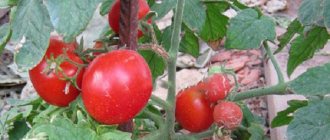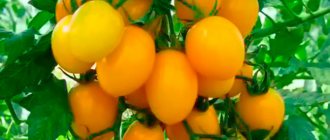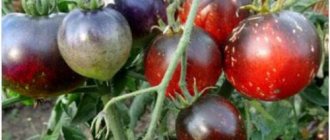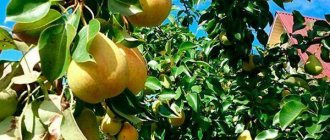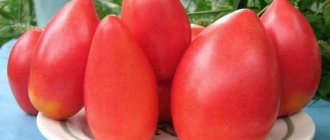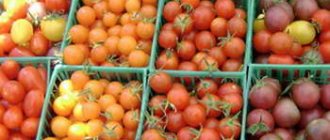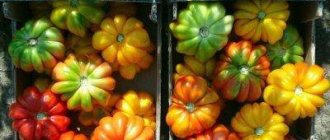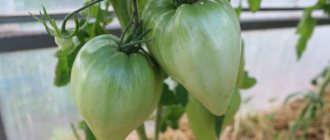The Red Fang tomato is very good for pickling and canning. It has small fruits of an interesting elongated shape, indeed vaguely reminiscent of fangs. The pleasant tomato taste and aroma, coupled with excellent productivity, make it a favorite of gardeners.
| Height | Landing location | Ripening time | Fruit color | Fruit size | Origin | Fruit shape |
| Medium height | Greenhouse, Open ground | Early ripening | Reds | Average | Variety | Plum-shaped or oval |
Greenhouse care: what to pay attention to
It was already indicated above that the Cone variety is a tall tomato that needs supports and a garter. The ideal option is to make trellises in the greenhouse, and then gradually, as they grow, tie the stems and branches of the plant to them.
The trellis method is very convenient:
- all bushes in the greenhouse receive uniform lighting;
- Tomatoes are easy to care for: feed, water;
- stems and branches do not bend under the weight of fruits, plant breakdowns are avoided;
- there are drafts in the greenhouse, minimizing the risk of infections.
It is also recommended to make grooves or holes in the greenhouse for watering tomatoes. This will allow you to water the plants exactly at the root, the soil will be well moistened, and moisture will not get on the leaves and flowers of the tomatoes.
Water the Cone depending on the weather, rarely and abundantly. If the days are hot, then you need to water at least 2-3 times a week; in cloudy and cool weather, you can limit yourself to one watering every 5-7 days. Be sure to ventilate the shelter, open all doors and windows after watering. In a closed greenhouse, air humidity immediately rises sharply, and such conditions are unfavorable for tomatoes. If it is not possible to leave the greenhouse open, then you need to take care of mulching the soil. Mown grass, peat, humus, and sawdust are suitable for this.
ON A NOTE! Be sure to control the water temperature - not lower than +20ºC.
Watering is very often combined with the application of fertilizers, since in this case the absorption of the necessary elements by the plant is more effective. The Cone variety is “fed” at least 4-5 times per season, taking into account the condition of the tomatoes, the weather, and also observing the dose of fertilizers.
In the first weeks of the growing season, organic matter is suitable - manure (horse, cow), poultry droppings, as well as ash (infusions). Manure must be diluted with water (1:10), and bird droppings are diluted in the same way (1:20). Wood ash saturates plants with potassium, but it is advisable to use an infusion for fertilizing.
Tomatoes are very fond of green infusions - from nettle, dandelion, and other weeds, which usually grow in abundance at the boundaries of the plot. The grass is mowed, a barrel or tank is filled halfway, filled with water and infused for about 5-7 days. Water the tomatoes with this “tea” strictly at the root, diluting with water (1:10).
From the moment of flowering, and then during the formation of fruits, plants need other elements, so nitrogen is limited, and the dose of potassium and phosphorus in fertilizing is increased. Ash, superphosphate, and potassium sulfate are added. Tomatoes respond well to fertilizing with special compounds, which are sold in variety in specialized stores - Ideal, Kemira, Agricola. Complex fertilizers, for example, nitrophoska, are also suitable.
ATTENTION! All fertilizing with ready-made formulations is applied strictly according to the instructions, not exceeding the recommended norms and taking into account the growing season (flowering, fruit formation, ripening of tomatoes).
Spraying is used as a preventive measure against diseases and various pests:
- Bordeaux mixture;
- copper-containing preparations;
- garlic infusion;
- composition with whey.
Gardeners are also in demand for compounds that can significantly increase the yield of tomatoes. Among them are iodine, boric acid, baker's yeast. Also, for better pollination, it is recommended to lightly shake their branches during the flowering period of tomatoes so that the pollen falls freely. It is better to do this between 9 and 11 am, and very carefully.
Don't forget about removing stepchildren. The procedure is carried out in the morning, removing all shoots in the sinuses, but leaving a small “leg” (up to 1.5 cm). It is better to break out the stepsons, but you must be careful not to damage the stem of the plant.
When forming into two trunks, only one stepson is left on the tomato, under the first flower cluster. In the Cone variety it is very powerful and almost similar in thickness to the main stem. All other shoots are removed.
If you want to grow large fruits, you will need to remove some of the inflorescences from the plant's raceme, leaving no more than 4 flowers. But usually the Cone does not form clusters; the fruits grow even and large.
Tomatoes are harvested after about 115 days, when they reach the desired size and weight. Their skin is still green, but the fruits can ripen at home. Such harvesting will increase the overall yield from the bush, while the fruits ripening on the plant will slow down the formation of tomatoes on other clusters.
If you want to collect your own seeds from the Cone fruits, leave the best and most beautiful tomatoes on the bush until they are fully ripe. The seeds are then fermented from them, dried and used the next year for sowing.
Important!
Tomato Count Orlov - description and characteristics of the variety
Fans of vegetable plantings like tall butts. The Graf Orlov variety is the most popular among such crops, delighting many gardeners with early-ripening, aromatic tomatoes.
Breeders clearly describe this type of tomato:
- The variety is intended for growing in beds or in temporary shelters.
- The plant reaches a height of about 180 centimeters.
- Tomato belongs to indeterminate varieties.
- It ripens to lay down with chickens (the period from planting seedlings in the ground to harvesting the first harvest is 105 days).
- Flowering leaves are dark green.
- Up to ten clusters are formed, each of which grows up to six tomatoes.
Garden owners grow this type of tomatoes in unheated greenhouses made of film or plastic. The variety actively bears fruit.
You can find a variety of English selection that bears the subtitle “Orlov yellow giant tomato.” This variety produces yellow eggs that weigh more than one kilogram. Some people incorrectly believe that this is a special variety of tomato, Ladgraf Orlov.
Description of the harvest
Gardeners give the following description of early ripening fruits:
- the form of tomatoes is round, slightly flattened at the stalk, the surface is slightly ribbed;
- the weight of one fruit is up to 120 grams;
- the pulp is juicy and meaty;
- selected ones in ripe fruits are dark red;
- the taste is distinguished by sweetness with slight sourness;
- there are many chambers with seeds;
- the fruits have rich taste and aroma;
- The tomato peel is dense and not rough.
The purpose of tomatoes of this variety is global. They are used to make pasta, tomato juice, used as ingredients in salads, and included in vegetable cuts. Some of this variety of tomatoes make delicious stuffed baskets.
Positive qualities of the variety
Agrobiologists are developing new varieties of vegetable crops to increase productivity, resistance to disease development, and improve taste and marketing characteristics. Quality Count Orlov is loved by many gardeners. And there are many reasons for this, since these tomatoes:
- unpretentious;
- they ripen very early;
- resistant to fungal infections and major viral diseases;
- give moneybags a harvest;
- used for many culinary purposes.
It is worth noting the following: the taste of the resulting crop depends on the conditions in which it was grown. If the season turns out to be cool, then the fruits will not have as much juice, they will be more sour.
How to grow quality crops
At the end of the gardening season, you can get a rich harvest of high-quality aromatic fruits with excellent taste characteristics by strictly following the recommendations for growing and caring for this variety.
You need to slow down with the following simple rules:
- Forcing seedlings should be carried out in early spring (in the early days of the year).
- Bushes should be planted in open ground or greenhouses at the end of spring, or in early June, when spring matinees are left behind.
- It is imperative to feed the planted seedlings with double superphosphate.
- The beds need to be covered with grass, straw or black non-woven material.
- It is contraindicated to over-moisten the soil (watering is carried out only after the soil seems to be completely dry).
- The bushes form into one stem.
- Frequent stepsoning is recommended.
- The bush must be tied up.
- The plant should be fed with mineral fertilizers, taking into account the manufacturer's recommendations.
This variety of tomato does not like excessive amounts of nitrogen in the soil. Vegetable crops fatten: all available forces are spent on growth, while fruits are not formed at all.
Fertilizers containing potassium and phosphorus help stimulate fruit growth and improve their taste. Due to the 14 days before harvest, it is necessary to finish enriching the crop.
If you strictly follow all the listed recommendations for growing and caring for tomatoes of this variety, then it is not forbidden to obtain high-quality and strong bushes and harvest a rich harvest of tasty and aromatic fruits.
What do gardeners think?
The hybrid, which appeared a long time ago, has firmly occupied a special place in the hearts of a large number of gardeners. This variety is valued because it is unpretentious, ripens quickly, is juicy and has a universal variety. One of the negative aspects is that the bushes are prone to overgrowth, so you have to get rid of stepchildren all the time.
Late
Low-growing varieties intended for late harvesting are suitable for long-term storage of fresh tomatoes and other needs. In this category, you should pay attention to the following options:
- Titanium. Round, small fruits (up to 120 g) ripen in 135 days and can be used for all types of preparations. Adult plants grow no more than 50 cm, are resistant to fungi and other tomato diseases, are not sensitive to moisture deficiency, but require fertilizing during the period of active growth, gartering of trunks and do not respond well to a sharp drop in temperature.
- Rocket. Low bushes are resistant to all types of rot. Ripening occurs in 120-130 days. Per 1 m² you can collect up to 6-10 kg of elongated oval tomatoes weighing 50-60 g. They are suitable for canning, pickling, as well as long-term storage and transportation without loss of presentation.
- Finish. Gives a harvest in 130-135 days. Intensely red fruits weighing up to 90 g with juicy pulp have a dense skin that prevents them from cracking. They are distinguished by good keeping quality and transportability.
- Bobcat. A hybrid of Dutch origin with a growing season of 120-130 days, resistant to adverse weather conditions (including drought) and most diseases of nightshade crops. On bushes 50-70 cm high, slightly flattened tomatoes weighing up to 250-300 g ripen.
Related article:
Feeding tomatoes with folk remedies
Growing rules
Seedlings should be given 55 to 60 days to fully develop and be ready for transplantation. It is recommended to grow the crop in seedlings to avoid problems with the growth of tomatoes and the development of a number of serious diseases.
It is not necessary to disinfect high-quality seed material, only if the farmer is one hundred percent confident in the quality of the seeds. But germination for better germination may be a smart idea.
To sow tomatoes of the Red Hunter variety, choose small containers with drainage holes. The containers are filled with moistened soil containing peat granules. If desired, the mixture is prepared using fertilizers. If additional fertilizers are not applied, then liquid nitrogen material must be used after the formation of several true leaves.
To germinate tomatoes, you should choose a dark place with a stable temperature of 21-27 degrees. At this stage, soil moisture plays an important role.
Important! To prevent moisture from evaporating quickly, the containers are covered with film or plastic.
As soon as the seedlings hatch, the temperature can be lowered slightly. At this stage, intense lighting plays an important role, which can be natural or artificial.
Characteristics and description of the variety, yield
Tomato Crystal is a hybrid from the famous French producer of seed material, Clause, whose varietal samples enjoy a well-deserved good reputation and great millet. Like other hybrids from breeders from France, the variety has many advantages. This is an indeterminate type of tomato, which is distinguished by its tall bush growth, compact, approximately identical fruits weighing from 120 to 160 g. Small three-chambered fruits of a rich red color, with no lettuce or green spots on the peel, and a small number of seeds in the seed cells.
The variety is grown in greenhouses all year round, so it can often be seen on supermarket shelves. Unlike other varietal hybrids, it has a bright, pronounced taste, sweet and slightly sour. This gives it an original aftertaste when eaten fresh.
Fact! It is considered one of the optimal varieties for canning, due to the approximately equal small size of the fruits and the ability to maintain their natural shape, thanks to a 6-8 mm thick wall.
Farmers are willing to grow Crystal because it is resistant to almost all diseases of nightshade fruit trees. The bush, despite its considerable height, grows with stable stems and a large number of tomatoes on the clusters. According to gardeners, 10-12 small fruits grow on the cluster, which are convenient to pick from the bush. They ripen almost simultaneously, easily move away from the stalk, the weight of all tomatoes picked from one bunch is more than one and a half kg.
When growing for commercial profit, you can pick tomatoes from the bush with tassels. This reduces the compactness of installation, but significantly increases the keeping quality. maintaining taste and fresh appearance. The brush is very easily separated from the main stem when mature, and the height of the bush allows you to harvest without additional time and labor costs.
In general, the variety receives favorable reviews from domestic breeders, and is included in the State Register of tomato varieties approved for cultivation in the Central and Central Black Earth regions. The manufacturer advises limiting yourself to 1 stem and removing all side shoots to increase fruiting. Domestic gardeners, especially when growing in greenhouses, prefer double-stem formation and garter using a trellis method.
In the south, Crystal is grown in open ground due to the short period of fruit ripening (65-70 days). On soil without shelter, the bush turns out to be lower, but strong, with a dense and strong stem, dark green foliage and requires constant pinching.
Important! Despite the restrictions of the State Register, the Crystal tomato grows well in different weather conditions and areas with problematic climates, and in a greenhouse it produces a consistently high yield. Repeatedly included in ratings of the best early varieties for cultivation in greenhouse conditions. The variety is intended for universal use, suitable for fresh eating, heat treatment and canning.
The variety is intended for universal use, suitable for fresh eating, heat treatment and canning.
Without stepsoning
Removal of stepsons is carried out in order to increase productivity. But if you don’t have time for such activities, you can purchase seeds of low-growing tomatoes, which will not need this procedure during the growing process.
- Watercolor. The bushes grow up to 50 cm, show resistance to drought and various diseases (including rot). They begin to bear fruit in 115-120 days. Elongated tomatoes weighing 80-120 g with thick skin and juicy pulp are suitable for salads, sauces, pasta and winter preparations. Also suitable for long distance transportation.
- Red Fang. Among the advantages of the variety: unpretentiousness, disease resistance and good yield. On day 85-95 you can get sweet, bright red tomatoes with dense flesh, suitable for fresh salads and canning.
- Duckling. Plants do without pinching, but require staking. They are valued for their disease resistance and fruit production, regardless of weather conditions. Bright orange tomatoes with a “spout” are characterized by a weight of 70-90 g and a high content of beta-carotene and sugars.
- Little Red Riding Hood. The variety came to Russia from Germany, where it is known as Rotkäppchen. Bushes up to 70 cm high do not require staking due to strong stems and produce up to 2 kg of harvest. You can count on your first collection in 95 days. Each bunch produces 4-5 red-orange tomatoes weighing about 50 g each. They have a round shape with slight ribbing.
Related article:
How to make tomatoes turn red
Tips for summer residents: The benefits of pinching tomatoes and timing
Criterias of choice
Typically, each gardener chooses short tomatoes based on his own preferences for ripening time, size and color of the fruit, and taste characteristics. In addition, several other factors should be taken into account:
Features of the greenhouse. For summer buildings (for example, made of cellular polycarbonate), it is better to choose early-ripening varieties that are resistant to temperature changes or extreme heat.
For heated winter rooms, you should pay attention to options with a short growing season and tolerance to a lack of sunlight. If there are problems with water supply, you need to plant plants that are drought-resistant and not prone to cracking.
Growing goals
For personal needs, it is enough to focus on your tastes; for subsequent sales, give preference to high-yielding and transportable varieties.
Related article:
To prevent tomatoes from becoming fattened with greens: 5 tricks
Purpose of tomatoes. It is advisable to decide in advance on the required quantity of early vegetables and those that will be used for storage and preparation, including separately for their different types. For example, for whole-food preservation it is worth focusing on small- and medium-fruited varieties; for fresh salads, processing into tomato juice and similar products, large fruits are suitable.
Disease prognosis. In closed ground, pathogenic microorganisms accumulate more, and when growing only tomatoes in a greenhouse for several seasons in a row (without crop rotation), the risk of infectious diseases increases significantly
In this case, it is recommended to pay attention to the latest disease-resistant hybrids. And when choosing non-hybrid forms, you need to think through the process of disinfecting seeds and the greenhouse, ventilation and subsequent treatments.
Read about varieties of low-growing tomatoes for open ground in the article
Self-pollinating
This category does not require the participation of insects to pollinate plants, which greatly simplifies their cultivation in a greenhouse. Seeds of low-growing tomatoes with similar characteristics include the following varieties:
- Mystery. Bushes 45-50 cm high have a strong trunk. Other advantages include: resistance to many diseases, good development even with a lack of sunlight, and ease of care. The first harvest ripens after 82-88 days. Round tomatoes weigh up to 100 g and hold their shape well, without cracking even with excessive amounts of moisture.
- Gull. A highly productive, disease-resistant variety with a ripening period of 90-98 days. The bushes grow up to 50-70 cm and produce round, slightly flattened fruits weighing 75-80 g, suitable for canning. When creating favorable conditions in the greenhouse, the weight can increase by 100 g.
- Ballerina. The height of adult plants reaches 60 cm. You will have to wait about 105 days before the first harvest. Red pepper tomatoes are distinguished by dense pulp, thin skin and pleasant taste characteristics.
- Pink honey Already from the name you can understand that these will be pink-colored fruits with a sweet taste. Average weight is 600-800 g. Individual specimens reach 1000 g. They are suitable mainly for salads. Productivity is up to 18 kg per 1 m². But plants are susceptible to diseases and therefore require careful care.
Related article:
What to do if tomato seedlings are stretched out and thin
You can further increase the number of ovaries on self-pollinating varieties by shaking the stems or using a fan.
Rules of care
The application of fertilizer to the soil plays an important role. The use of high-quality material, taking into account the phases of tomato development and the composition of the soil, will allow the plant not only to develop correctly, but also to rarely get sick. The first feeding occurs after transplantation. It is advisable to use nitrogen fertilizer and add enough calcium, which will have a positive effect on the development of the tomato root system. Organic matter is also of great importance, and must be used in the same volume as complex mineral fertilizers. Materials are applied alternately. Particular attention should be paid to fertilizing during flowering and at the ripening stage of tomatoes
The importance of proper watering cannot be underestimated. Experienced farmers know that the soil should not dry out. In order not to over-moisten the soil and deliver moisture to the roots, irrigation is carried out using the drip method.
Reducing watering at the time of ovary formation will help avoid fruit cracking. To further strengthen the root system, it is useful to carry out regular loosening. And to protect against adverse external factors, it is advisable to use mulch, which prevents moisture evaporation and prevents the soil from overheating. This is excellent protection even if the air temperature drops.
Description of the tomato variety Sinichka, recommendations for growing
A valuable crop of the nightshade family has long occupied a place of honor in gardeners’ beds. Every year the number of tomato varieties only increases. Today, everyone can choose a suitable type, focused on climatic conditions and personal preferences. Tomato Sinichkam will please those who do not have a large summer cottage. The miniature plant is suitable for cultivation at home, on balconies and window sills.
General information about the plant
Sinichka tomatoes can delight the owner with delicious fruits all year round, provided they are cultivated at home. The variety is also suitable for open ground. Description of the appearance and general characteristics of the tomato:
- Early ripening, the berries are ready for picking 85–95 days from planting.
- Determinant.
- Standard.
- Simple brushes.
- Low-growing, height does not exceed 40 centimeters.
- Miniature, decorative.
- Medium sized foliage.
- Simple inflorescences.
- The number of fruits in a cluster is 10–15 pieces.
- The stem ends the inflorescence.
- Good yield, 2.8 kilograms of berries are harvested per square meter of planting.
- Resistance to many diseases of the family.
- Increased shade tolerance.
- High percentage of berry set.
- Good keeping quality.
- Transportable.
Decorative bushes serve as decoration for any home, and the tasty fruits are rich in nutrients. The fruits of the Sinichka variety are distinguished by:
- Cherry shape.
- Small, weight does not exceed 20 grams.
- Sweet, with a honey aftertaste.
- Juicy yellow color when ripe.
- Dark spot near the stalk.
- Not watery.
- Smooth.
- Dense.
- Thin skin.
- Not prone to cracking.
- Strong tomato aroma.
Recommendations for cultivation
Fans of miniature Sinichka tomatoes often choose the plant for home growing. Cultivating tomatoes at home requires following a number of rules:
- Selecting a container for planting. The recommended height of the boxes is 12–15 centimeters.
- For better air access, you need to place pieces of tiles, slate and add sand at the bottom of the selected container.
- A universal soil for tomatoes is suitable as a soil.
- Maintaining a daytime temperature of 20 degrees and a night temperature of at least 14 degrees.
- Regular ventilation of the room.
- Installation of an additional light source.
IMPORTANT! The plant does not like high humidity; in case of home cultivation, the tomato should not be placed next to wet laundry
Gardeners' opinion
Good day to all! I have been growing Sinichka tomatoes at home for a long time on the balcony. The variety is early and unpretentious. A decorative bush decorates the apartment, and delicious berries bring joy even in the cold season. Bright, yellow tomatoes are small in size, but very sweet. I recommend!
Ekaterina Voronina, 55 years old
Good afternoon! I advise all cherry tomato lovers to try the Sinichka variety. It can be easily cultivated right at home, on the balcony. A box or a regular old pan is suitable as a container for planting. The plant responds positively to feeding and loves watering. It is advisable to regularly ventilate the room and install fluorescent lamps. The bushes are low-growing, very compact. The berries weigh about 20 grams, are regular in shape and taste sweet. I recommend!
Pests and diseases
The tomato is resistant to most viruses and fungi. The crop ripens before late blight begins to spread.
To protect plants, the following preventive measures are sufficient:
- the greenhouse requires regular ventilation;
- watering should not be excessive;
- balanced feeding is required, containing nitrogen, potassium and phosphorus;
- calcium is needed to prevent blossom end rot;
- plants are periodically sprayed with Fitosporin or folk remedies to avoid diseases;
- Before planting, disinfect the soil and seeds;
- observe crop rotation.
The tomato is not resistant to pests; it is attacked by the Colorado potato beetle, aphids, spider mites, whiteflies and other parasites. It is necessary to regularly inspect the plantings and, if signs of disease appear, treat them with folk remedies. This is a solution of laundry soap, whey, wood ash, tobacco infusion, onion peel, crushed garlic. If all else fails, insecticides are used.
Description of the Red Fang tomato variety, its characteristics and yield
An increasing number of gardeners, when choosing tomato varieties, rely on reviews from real people
Fans of low-growing, high-yielding varieties are advised to pay attention to the Red Fang tomato variety. Despite the small growth and compactness of the bushes, the garden crop is able to please with the yield of tasty fruits of an unusually shaped tomato
Description of the variety
The Red Fang tomato variety is grown in open ground conditions. The plant belongs to the determinate species and is characterized by compact bushes with a small mass of greenery. Short ripening periods make it possible to obtain early fruiting.
Fruit characteristics:
- Tomatoes have a rich red color.
- Tomatoes are characterized by an elongated shape that looks like a fang, thanks to which the variety received its unusual name.
- On average, the weight of one fruit reaches 90 grams.
- The yield for low bushes is considered high and on average up to 10 vegetables are harvested from one bunch.
- Fruit yield indicators largely depend on the growing region and climatic conditions.
The pulp of the fruit is distinguished by good fleshiness and there are no notes of acid in the taste. Thanks to the thin skin, vegetables lend themselves well to cutting, after which they do not fall apart. Reviews from gardeners indicate that some specimens are up to 15 cm long and note a small number of seeds.
Red fang is consumed fresh, but due to its neat elongated shape, the fruit is often used as a canning material. The main direction for long-length fruits is to use them in salads, which acquire a rich, bright taste.
Vegetables of this variety withstand heat well and are able to maintain their proper appearance after processing.
Growing
Cultivation is carried out in the traditional way through seedlings. Planting material is placed in small containers and covered with film. After the formation of 2 or 3 leaves, a dive is made. To form strong shoots, it is necessary to ensure sufficient light, with a deficiency of which the seedlings become elongated and thin.
Seedlings are planted in a place of permanent cultivation after there is no threat of return of frost. The area must be protected from strong gusts of wind. The soil is prepared in advance and enriched with mineral complexes.
Features of care
Plant care has no specific features. It is necessary to provide weeding, periodic watering, as well as several fertilizing with mineral complexes during the growing season.
When watering, do not allow moisture to get on the leaf plates, otherwise burns may occur when exposed to sunlight. The recommended watering times are morning and evening hours.
Advantages and disadvantages
The advantage of growing a low-growing variety is that there is no need to provide large areas for planting. With this choice, it is possible to save time and effort, since the plant does not need pinching.
Pests and diseases
Due to its low growth and small amount of green mass, as well as the short period of fruit ripening, the variety has good resistance to most types of tomato diseases of viral and fungal origin. When growing a Red Fang tomato, you don’t have to be afraid of a disease such as late blight.
Harvest and storage
The fruits are not intended for long-term storage, so it is recommended to consume them immediately after harvest. Unripe tomatoes can be placed in a cool, dark place until they turn red.
In most cases, the plant manages to supply the required amount of nutrients and there is enough time for the fruit to fully ripen due to the short growing season. Such features lead to the fact that the number of “green” tomatoes by the end of the gardening period is insignificant.
High-yielding
Tomato productivity indicators depend not only on the microclimate of the greenhouse and compliance with plant care rules. There are special low varieties that are predisposed to more intense fruiting compared to their relatives. Among them, the following are well suited for closed ground:
- Rajah. Plants grow up to 100 cm and produce their first harvest after 85-100 days. From 1 m² of plot you can get up to 25 kg of tomatoes. The oblong fruits weighing 200-300 g have dense pulp and a sweetish taste. Well suited for fresh consumption and preparations.
- Grouse. Bushes 50-100 cm high produce up to 15 kg of yield per 1 m². Ripening period – 111 days. Large red tomatoes (up to 300 g) with intermittent yellow stripes have a sweetish taste. Due to their resistance to cracking, they are suitable for fresh storage, as well as canning and pickling.
- Golden domes. From one bush you can get up to 11 kg of large fruits with excellent taste characteristics and presentation. The average weight is 400 g, with good care - up to 800 g. But you will have to wait up to 3.5 months before they ripen.
- Tanya F1. Compact bushes up to 60 cm high have delicate stems, so they require tying, and in the process of ripening tomatoes, installation of supports. They produce up to 5 kg of tomatoes weighing about 150 g each.
Related article:
How to help seeds sprout faster and produce good seedlings
Characteristics of early ripening tomato Red Fang, cultivation and care
The early-ripening tomato Red Fang appeared on the seed market not too long ago, but has already been tested and appreciated by gardeners. Over the course of several years, the country's vegetable growers managed to try to grow it in open and closed ground and in different climatic conditions of Russia.
General description of the variety
The plant is of a determinate type, low-growing, standard-shaped. Tomato bushes of the Red Fang variety are compact and do not require pinching. The height of the bush reaches 80-90 cm, and with a large load of fruits it becomes unstable. To avoid falling over, plants need to be tied to a support or trellis.
Fruiting is extended, ovaries are formed during the summer. During the season, several large clusters with fruits manage to form on the bush. The growing season lasts about 3 months, and then the bush matures and stops forming new inflorescences.
The Red Fang variety is an early ripening variety. The first harvest of fully ripened tomatoes can be harvested 90-100 days after sowing the seeds. When planting bushes in a greenhouse or film greenhouse, you can get fresh vegetables for the table as early as June, but in open ground, tomatoes begin to ripen in mid-summer.
Reviews from amateur vegetable growers note the high yield of the variety: the bushes are strewn with small, bright berries. From 1 m² you can collect up to 12 kg of marketable products per season. With a sharp change in weather in the Siberian region, the tomato does not stop bearing fruit and quickly recovers from stress. Tomatoes tolerate dry, hot weather well, do not drop buds and continue to form ovaries.
Red Fang tomatoes are resistant to most fungal diseases. Late blight is rarely affected, managing to yield almost the entire harvest before the massive spread of the pathogen at the end of summer. They do not suffer from blossom end rot and are immune to tobacco mosaic.
Features of the fruit
Tomatoes are collected in clusters of 15-20 pieces. The weight of 1 berry is 40-60 g, the ovaries, which are the last to form on the cluster, often lag behind the rest in size. The shape of the tomatoes is ovoid, slightly elongated, finger-type.
The skin is very durable, the berries do not crack when ripe, even in conditions of excessive humidity. Tomatoes can be transported at the stage of full ripeness; they can retain their presentation for a long time. Unripe tomatoes ripen easily in room conditions. The color at technical ripeness is uniform, light green. As the fruits ripen, they turn red.
The pulp is dense, elastic even in a state of biological ripeness. Seed chambers 2 pcs. The walls are thick, up to 1 cm. The flesh is uniformly colored and red. The taste qualities are rated as high: the fruits are sweet, sometimes with a slight piquant sourness. The aroma is classic, tomato.
The Red Fang variety is recommended for fresh consumption. Early and tasty tomatoes make good summer salads. Small fruits are suitable for decorating dishes and creating portioned snacks for a buffet table. A tomato cut into pucks or slices can decorate a canape, sandwich or hamburger. The pulp is included in any dishes with tomatoes: soups, gazpacho or sauces.
Elongated tomatoes are convenient to preserve whole. They look beautiful in a jar, and when served, their ability to maintain a dense pulp structure when marinated and salted becomes noticeable. From fully ripened tomatoes you can make juice or a filling for lecho and tomato-based snacks. The consistency of the pulp and its sweet taste make it possible to use the Red Fang variety for making sun-dried tomatoes.
Agricultural technology varieties
Sowing of early ripening varieties begins 50-60 days before they are planted in a permanent place. For sowing, prepare a substrate from equal parts of humus, garden soil and fine sand, adding 2 tbsp for every 10 kg of mixture. l. chalk or dolomite flour. To disinfect, soak the soil scattered in boxes with a hot dark solution of potassium permanganate.
You can prepare tomato seeds yourself if your first acquaintance with the Red Fang tomato was successful. But these seeds will have to be neutralized in a solution of potassium permanganate or Fitosporin. The grains are soaked in warm liquid for 30-40 minutes, and then dried until free-flowing. You can sow them as soon as the soil cools down.
Place for germination in a warm place (+25°C). Under such conditions, tomato seedlings appear within 4-5 days. After this, the film should be removed. The tomatoes can remain warm for the first few days, but after about 1 week they can be moved to cooler conditions (about +20 °C during the day and not lower than +16 °C at night).
Large-fruited
The harvest of large-fruited, low-growing tomatoes is usually used for fresh consumption, as well as for the preparation of juices, pastes, and ketchups, but due to its size it is not suitable for whole canning or pickling. For greenhouses, you can choose the following options:
- Gift for a woman. A variety with good yield (up to 30 pieces per bush) and resistance to diseases of nightshade crops. Red-raspberry fruits weighing up to 250 g will be equally good in salads and in juices or ketchup.
- Alsou. The bushes grow up to 80 cm and produce a harvest even in unfavorable weather conditions, but they definitely require garter. Kidney-shaped tomatoes ripen in 105-110 days and weigh up to 500 g (sometimes up to 800 g).
- Big Mama. A young variety that appeared only in 2015. In a greenhouse, fruiting begins 85 days after planting. The average weight of a tomato is 300 g, so a garter is required (and this must be done in advance, since rapid weight gain may damage the stems). Among the features: tolerance to light and cold, mandatory pinching for good yield.
- Openwork F1. An early hybrid resistant to powdery mildew, blossom-end and root rot. The ripening period is 100-110 days, the height of adult bushes is up to 80 cm, the weight of the fruit is up to 400 g (with a bush height of up to 80 cm).
Related article:
Tomato Tsarsky Gift - description and characteristics of a high-yielding variety
